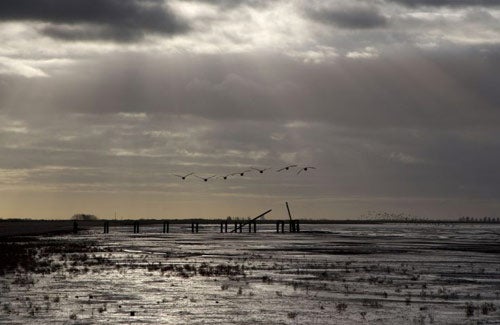Birds, beauty and endless space – it'll all come out in the Wash
The East Anglian estuary is a world class birding spot, says Andrew Spooner

What makes a beautiful landscape? Most people would probably suggest a place untamed by human hand. We want drama, majesty and a sense of transcendence – a place to lose ourselves.
Today my eye is cast over the Wash, a massive, flat mud plain, bound by salt marsh and cut through with hundreds of snaking rivulets that create thick sludge and exotic swirling patterns. It hardly fits the traditional image of beauty, yet it's growing on me.
A giant cloud of birds descends, so huge in number that the skies darken - waders, geese, seabirds, diverse in species and colour, spin down in formation to land deftly on the mire.
"This is one of England's few remaining wildernesses," says RSPB public relations officer Ciaran Nelson, as we watch the unfolding scene. "The Wash is a major feeding station for the planet's wild bird population. At certain times of year we have almost half a million birds here."
The RSPB attaches such significance to near-shore marine sites such as the Wash that it has just released a report called Safeguarding Our Seabirds in order to provoke the Government into affording sensitive shoreline areas better protection. "As a nation we do a great deal to protect special on-shore sites," says Ciaran, "but it's about time the British coast was safeguarded in the same way."
This month the Government published its long-awaited Marine Bill, which promises protection for wildlife. The RSPB largely welcomes this.
"The draft Marine Bill is a big step forward, but we hope it goes far enough to protect such outstanding sites as the Wash. The creation of marine conservation zones which we hope the Bill will recommend should help areas like this, as there is no protection for seabirds' off-shore breeding colonies," says Ciaran.
Set on the eastern fringe of England – the Wash is the square, gouged lump taken out of the western end of Norfolk's coastline – this gathering of birds and mud makes up the largest estuary in the UK. "The global importance of the Wash shouldn't be underestimated," says Ciaran, as more flocks descend on to the flat vista. "It's slap bang in the middle of various migratory routes. We get birds from the Arctic to Africa stopping off here. The Wash is akin to a giant smorgasbord of shellfish of all description. Best of all for the birds, there are very few natural predators here so they can chow down undisturbed."
We get in Ciaran's car and head up the coast to Hunstanton, a cliff-top town overlooking the Wash. To the south, the cliffs, layered with two giant stripes of ruddy sandstone and bright, white chalk, tower above us like a mammoth Battenburg cake. I notice elegant seabirds diving off the cliff face. "They're called fulmars," says Ciaran, "They're renowned for vomiting a thick oily bile on to anything that threatens them, so don't get too close."
With the vomiting birds circling overhead, Ciaran shows me another wonder of Hunstanton beach. Cast over the sands are dozens of large, brown, fossilised objects. Some are half-buried, sticking out at unusual angles; the rest round slices of dark, flaky rock. "These fossils are the remains of an ancient prehistoric forest," says Ciaran. "Funny to think that, at one point, the whole of the Wash would have been filled with thick woodland."
Back on the road, we head east until we arrive at the Titchwell Marsh RSPB reserve. "This is busiest RSPB visitor centre in the UK," says my RSPB guide, Richard Burton, as I arrive at a small wooden building set on the edge of a large run of marshland. Inside the centre are chalkboard lists of bird sightings, computer screens showing bird species, and some incredibly expensive binoculars.
The Titchwell Marsh reserve is mostly made up of unique freshwater lagoons and a run of salt marsh that leads right up to distant dunes and the sea. With a population of little egrets, tufted ducks, brent geese, oystercatchers and several raptors, this is a perfect location for bird watching.
"The little egret is the hardest to find because it is camouflaged by the reed beds," says Richard, as we settle down in a hide by a lagoon. Alas, on the egret front we fail. But it's no matter. My trip to the Wash has introduced me to some sublime landscapes in a place I wouldn't have sought them out. Its beauty is truly in the eye of the beholder.
COMPACT FACTS
How to get there
Andrew Spooner travelled to the Wash on the new Triumph Tiger (01455 251700; triumphmotorcycles.com). He stayed at Titchwell Manor Hotel (01485 210221; titchwellmanor.com), which offers b&b, in a double, from £110.
Further information
RSPB Titchwell Marsh (01485 210779; rspb.org. uk). For a free 'Rural Escapes' brochure contact Enjoy England (0845 603 6940; enjoyengland.com/ruralescapes).
Subscribe to Independent Premium to bookmark this article
Want to bookmark your favourite articles and stories to read or reference later? Start your Independent Premium subscription today.

Join our commenting forum
Join thought-provoking conversations, follow other Independent readers and see their replies